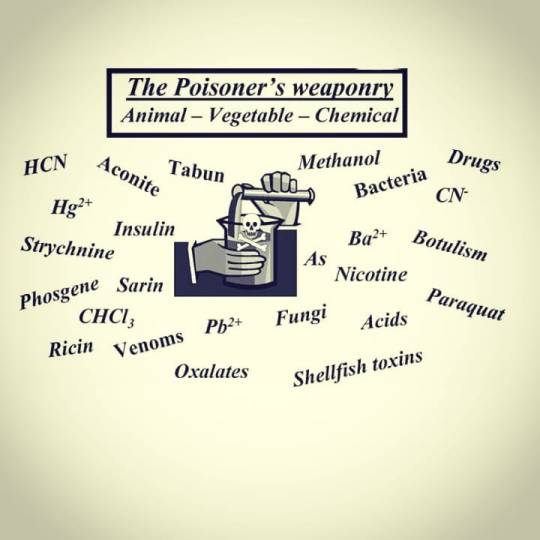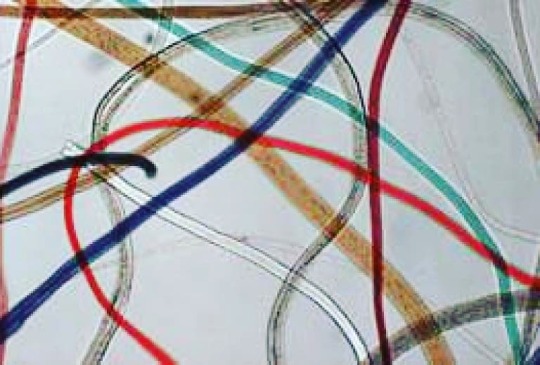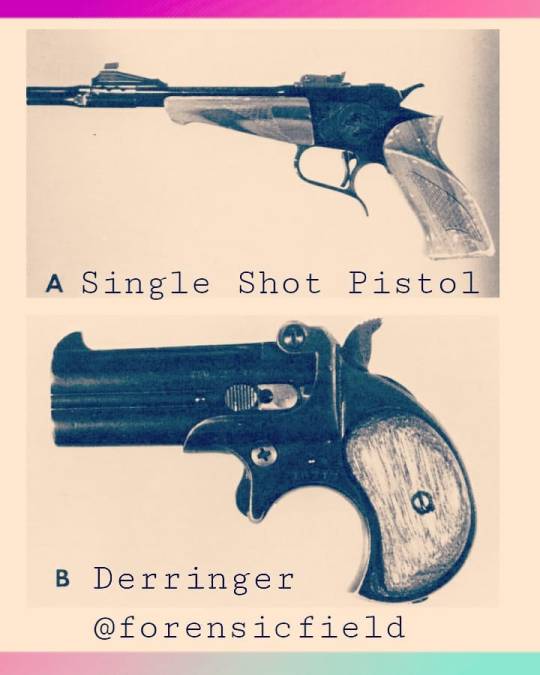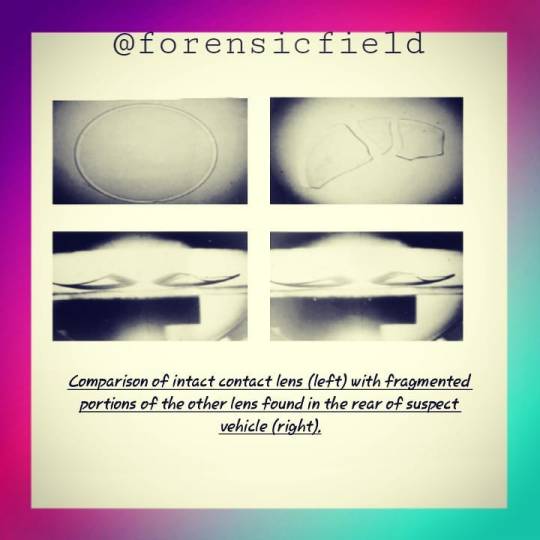#forensicnotes
Photo

Questions- What is difference between Poison, Toxin And Venom?
Answer- Poison, toxin, venom are terms for any substance that injures the health or destroys life when absorbed into the system.
☣ Poison: Poison, in biochemistry, a substance, natural or synthetic, that causes damage to living tissues and has an injurious or fatal effect on the body.
☣ Toxin: A toxin is a poison produced by an organism.
☣ Venom: Venom is especially used of the poisons secreted by certain animals, usually injected by bite or sting.
Question- What quantity of a poison would be necessary to produce a lethal out-come in a human victim?
Answer- There are several considerations to keep in mind for poisoning.
Studies revealed that small doses of a substance might be harmless or beneficial, whereas larger doses could be toxic. This is now known as the dose-response relationship, a major concept in toxicology. A poison is any substance that can cause illness or death when ingested in small quantities. This definition excludes the multitude of substances that cause damage if ingested in large quantities.
For example- A dose of aspirin (acetylsalicylic acid) that is harmless to an adult may be poisonous to an infant. Similarly, an elderly person’s tolerance of a substance may be much lower than that of a healthy young adult.
Lethal Amount of poison is also depend on person, poison and many other factors, such as; Lethal dosage often varies depending on the method of administration; for instance, many substances are less toxic when administered orally than when intravenously administered.
#poison#toxic#forensic#forensicscience#forensicfield#forensictoxicology#lethaldose#poisoning#criminology#criminalistics#crime#crimesceneinvestigation#forensicinvestigation#forensicstudy#forensicknowledge#forensicnotes#bestofforensic#forensicmedicine#forensicfacts
5 notes
·
View notes
Photo

Analysis of Fiber Colors and Dyes
➿ The vast majority of fibers used in commercial applications are colored.
➿ Fiber color is one of the most important properties in the comparison of fibers.
〽️ There are a variety of methods for characterizing the color of the dyes in the fibers. They fall into three major categories:
1.) Visual:The visual method is the simple observation and comparison of the fiber colors by use of the unaided eye. Visual comparison is easy, fast, accurate and non- destructive.
It is a crucial first step in any fiber comparison, as many otherwise similar fibers can be excluded from consideration by color.
2.) Chemical:Chemical methods, which include thin layer chromatography and high performance liquid chromatography, address the make-up of the dyes used to color the fiber.
(This latter statement is an important distinction: analyzing the color of a fiber is not the same as analyzing the dyes used to color that fiber.)
3.)Instrumental-
Instrumental analyses include microspectrophotometry in the UV and/or visible ranges and, more rarely, spectrophotometric measurement of fluorescence.
#forensicfield#forensicscience#forensic#forensicinvestigation#forensics#crime#crimesceneinvestigation#fiber#fiberanalysis#analysisoffiberinforensicscience#forensicevidence#traceevidence#physicalevidence#forensicknowledge#forensicnotes#forensicworld
5 notes
·
View notes
Photo

Cartridge Cases
📌 Cartridge cases are usually made of brass, a composition of 70% copper and 30% zinc.
📌Less commonly, they are made of steel or aluminum.
📌 Zinc andplastic materials have been used experimentally.
📌 Brass, plastic, and paper are used for shot-shell tubes.
📌 The main function of the cartridge case is to expand and seal the chamber against rearward escape of gases when the cartridge is fired. When a brass cartridge is fired in a weapon, the gas pressure produced by the burning of the propellant expands the case tightly against the walls of the chamber. If the brass is tempered to the correct hardness, it will spring back to approximately its original dimensions and make the case easy to extract. If the brass is too soft, it will not spring back and will make extraction difficult. If the brass is too hard, brittle, it will crack.
👉 There are three general shapes for cartridge cases:
🕵️♂️ Straight,
🕵️♂️ Bottleneck,
🕵️♂️ and, Tapered.
Almost all pistol cartridges are straight, whereas almost all rifle cartridges are bottle-necked. The bottle-neck design permits more powder to be packed in a shorter, fatter cartridge than would be possible in a straight cartridge, where the lumen is approximately the diameter of the bullet. Cartridges with tapered cases are virtually obsolete.
Watch video for more information: https://youtu.be/Y6VUcFocLoI
#forensic#forensics#forensicfield#forensicscience#forensicballistics#ballistics#gun#primer#forensicstudy#forensicknowledge#forensicnotes#cartridgecase#cartridge#pistol#forensicnetjrfpreparation#forensicmultiplechoicequestion#forensiccriminology#forensicdivision#forensicsciencenotes#forensichistoryofworld#crimescene#crimesceneinvestigator#bullet#ballisticfingerprinting#justice#criminology#criminalistic
6 notes
·
View notes
Photo

Handguns:
There are four basic types of handguns:
1. Single-shot pistols
2. Derringers
3. Revolvers
4. Auto-loading pistols (automatics)
1. Single-shot pistols- A single-shot pistol has one firing chamber integral with the barrel, which must be loaded manually each time the weapon is to be fired.
2. Derringers- They are a variant of single-shot pistols. Derringers are small pocket firearms having multiple barrels, each of which is loaded and fired separately. The traditional derringer has two barrels.
3. Revolvers- The revolver is the most common type of handgun in the United States. Revolvers have a revolving cylinder that contains several chambers, each of which holds one cartridge. The cylinder is rotated mechanically so as to align each chamber successively with the barrel and firing pin. The first revolver was produced by Samuel Colt in 1835–1836.
4. Auto-loading pistols (automatics)- Auto-loading or automatic pistols make up the fourth category of handguns. The term “automatic pistol” is a misnomer, as this form of pistol is an auto-loader in which the trigger must be pulled for every shot fired. Regardless of the correct terminology, however, these weapons are invariably called “automatics” or just “pistols.”
#forensic#forensics#crimesceneinvestigation#criminalistic#forensicballistic#forensicstudy#gun#forensicscience#forensicmultiplechoicequestion#forensicdivision#forensiccriminalinvestigation#handguns#forensicknowledge#crimescene#criminology#forensicnotes#netjrfforensicpreparation
5 notes
·
View notes
Photo

Question- What is Forensic Glass Examination?
Answer- 👉Forensic examination of glass consists of the examination of two or more fragments to determine whether they have a common origin.
👉Identifying broken glass fragments having a common source to the exclusion of all other sources may only be done if they can be physically matched together.
Question- How will you analyse Glass fragments in lab?
Answer-
👉Submitted samples from a crime scene must first be confirmed as glass.
✔Differentiating glass from plastic is done by examining hardness, solubility, and observation with a polarized light microscope.
✔Once confirmed as glass, the examiner will perform an analysis of
📌physical properties, such as; color, fluorescence, thickness, curvature, density,
📌optical properties, such as; Refractive Index
📌and chemical composition.
✔ no further comparison is needed if any difference between questioned and known samples is found during analysis.
#forensic#forensicscience#forensics#forensicfield#forensicinvestigation#forensicglassexamination#glasscomparisoninforensic#evidenceanalysis#evidence#forensicevidence#crime#crimesceneinvestigation#forensicphysics#forensiclab#forensicscientist#forensicstudy#forensicknowledge#forensicnotes
3 notes
·
View notes
Photo

Practice Set 2. . .**************** Enhance your knowledge with @forensicfield. . Study with us.... . Like it, follow us, Comment your Answers. __________________________ ________________________ #forensicfield #forensicscience #forensicscientist #forensicpsychology #forensicmcq #forensicquestionandanswer #forensicquestion #forensicknowledge #forensicfact #forensicnews #criminology #crimescene #crime #criminalistic #forensiccriminology #mcqs #forensicquiz #forensicmcq #learning #forensiclearner #forensicnotes https://www.instagram.com/p/CAxWpsDj6uG/?igshid=1hedfq52srw4z
#forensicfield#forensicscience#forensicscientist#forensicpsychology#forensicmcq#forensicquestionandanswer#forensicquestion#forensicknowledge#forensicfact#forensicnews#criminology#crimescene#crime#criminalistic#forensiccriminology#mcqs#forensicquiz#learning#forensiclearner#forensicnotes
14 notes
·
View notes
Photo

Formulations for Chemical Solutions
1.) Ninhydrin (Kent, 1998; Champod et al., 2004, p 239)
Stock Solution: 25 g ninhydrin dissolved in 225 mL absolute ethanol, 10 mL ethyl acetate, 25 mL glacial acetic acid.
Working Solution: 52 mL of stock solution diluted to 1000 mL with HFE 7100.
2.) Zinc Chloride Solution (Champod et al., 2004, p 240)
Stock Solution: 8 g zinc chloride dissolved in 180 mL ethanol, 20 mL glacial acetic acid.
Working Solution: 6 mL of stock solution diluted to 100 mL with carrier solvent (e.g., HFE 7100).
3.) 1,8-Diazafluoren-9-one (DFO)
(Kent, 1998; Champod et al., 2004, p 230)
0.25 g of DFO dissolved in 30 mL methanol and 20 mL glacial acetic acid. Add this to 725 mL HFE 7100 and 275 mL HFE 71DE.
4.) Nonpolar Ninhydrin (Stimac, 2003a, pp 185–197)
Stock Solution: 1.5 g ninhydrin dissolved in 100 mL HFE 71IPA (may require refluxing at low temperature).
Working Solution: 15 mL of stock solution diluted with 100 mL HFE 7100.
5.) 1,2-Indanedione
0.25 g 1,2-indanedione dissolved in 90 mL ethyl acetate and 10 mL glacial acetic acid. Add this to 1 L of HFE 7100 (Merrick et al., 2002, pp 595–605).
or
2 g 1,2-indanedione dissolved in 70 mL ethyl acetate. Add this to 1 L HFE 7100 (Almog et al., 1999, pp 114–118).
6.) 5-Methylthioninhydrin (5-MTN) (Wallace-Kunkel et al., 2006, pp 4–13)
1.7 g 5-MTN dissolved in 52.5 mL ethyl acetate, 50 mL methyl tert-butyl ether, 12.5 mL absolute ethanol, and 5 mL glacial acetic acid. Add this to 360 mL HFE 7100.
7.) 2-Isononylninhydrin (INON, Thermanin) (Al Mandhri and Khanmy-Vital, 2005)
4–5 g INON dissolved in 15 mL ethyl acetate, 5 mL isopropanol, and 980 mL HFE 7100.
8.) Silver Nitrate (Trozzi et al., 2000, pp 38–39)
Dissolve 30 g silver nitrate in 1 L distilled water.
or
Dissolve 30 g silver nitrate in 100 mL distilled water and add to 1 L ethanol.
#forensic#forensicsciencenotes#forensics#forensicstudy#forensicscience#crimesceneinvestigation#criminalistics#criminology#forensicfield#forensicchemistry#chemicalformulations#crimescene#blooddetectionmethods#fingerprintdetectionmethod#forensicnotes#fact#knowledge#forensicknowledge
2 notes
·
View notes
Photo

Test your knowledge with 30 mcqs which have been selected from UGC/NET Examination 2018 Forensic Science (Paper II).
and check your answer at the last of this video.
Don’t forget to comment and tell us about your score out of 30.
Best of Luck.
#forensic#forensicscience#forensicfield#forensicstudy#forensicmcq#mcqonforensicscience#forensicknowldge#forensicnetexamination#netjrfforensic#criminology#criminalistic#foreniscmedicine#questioneddocument#forensicquestionandanswer#forensicmultiplechoicequestion#mostaskedquestion#netjrf2018forensicscience#foreniscanthropolgy#forensicnotes#forensicexamination#forensicandlaw#onlineforensic
2 notes
·
View notes
Photo

Different Definition Of Forensic Science
Which one is your Favourite?
Comment your definition of forensic science.
#forensic#forensics#forensicscience#forensicfield#forensicintro#forensicinvestigation#forensicstudy#forensicbiology#forensicevidence#criminology#crimescene#crimesceneinvestigation#criminalistic#forensicnotes#forensicmcq#forensicquestionandanswer#forensicdefinition#definitionofforensic
2 notes
·
View notes
Photo

Arsenic
Arsenic is naturally present at high levels in the groundwater of a number of countries.
Arsenic is highly toxic in its inorganic form.
Contaminated water used for drinking, food preparation and irrigation of food crops poses the greatest threat to public health from arsenic.
Long-term exposure to arsenic from drinking-water and food can cause cancer and skin lesions. It has also been associated with cardiovascular disease and diabetes. In utero and early childhood exposure has been linked to negative impacts on cognitive development and increased deaths in young adults.
Sources of exposure
👉Arsenic is a natural component of the earth’s crust and is widely distributed throughout the environment in the air, water and land. It is highly toxic in its inorganic form.
👉Fish, shellfish, meat, poultry, dairy products and cereals can also be dietary sources of arsenic, although exposure from these foods is generally much lower compared to exposure through contaminated groundwater. In seafood, arsenic is mainly found in its less toxic organic form.
👉Arsenic is used industrially as an alloying agent, as well as in the processing of glass, pigments, textiles, paper, metal adhesives, wood preservatives and ammunition. Arsenic is also used in the hide tanning process and, to a limited extent, in pesticides, feed additives and pharmaceuticals.
People who smoke tobacco can also be exposed to the natural inorganic arsenic content of tobacco because tobacco plants can take up arsenic naturally present in the soil.
🕵️♂️Detection:
The first real test for arsenic detection, The Marsh test, was discovered by James Marsh in 1836, and was used to reveal arsenic presence in case of arsenic poisoning in forensic science. It was the first method which could trace specifically the presence of arsenic in the body. It uses sulfuric acid and zinc.
The urine test is the most reliable test for arsenic.
#forensics#forensicscience#forensic#arsenic#poison#toxicology#forensictoxicology#criminology#criminalistic#forensicknowledge#knowledge#forensicstudy#netjrf#forensicnotes
2 notes
·
View notes
Photo

Chemical Components Of Insect Venoms ______________________ Enhance your knowledge with @forensicfield. . Study with us.... . Like it, follow us, Comment your Answers. __________________________ ________________________ #forensicfield #forensicscience #forensicscientist #forensicpsychology #forensicmcq #forensicquestionandanswer #forensicquestion #forensicknowledge #forensicfact #forensicnews #criminology #crimescene #crime #criminalistic #forensiccriminology #mcqs #forensicquiz #forensicmcq #learning #forensiclearner #forensicnotes https://www.instagram.com/p/CArwEg9jaYU/?igshid=iw8swomi5ikt
#forensicfield#forensicscience#forensicscientist#forensicpsychology#forensicmcq#forensicquestionandanswer#forensicquestion#forensicknowledge#forensicfact#forensicnews#criminology#crimescene#crime#criminalistic#forensiccriminology#mcqs#forensicquiz#learning#forensiclearner#forensicnotes
2 notes
·
View notes
Photo

Signs of Death
#forensicintro#forensicnews#forensiccriminology#forensicbiology#forensicmedicine#forensic#forensics#forensicscience#forensicfield#forensicinfo#forensiclaw#forensicnotes#criminology#crimescene#crimesceneinvestigation#forensicinvestigation#criminalistic#death#deadbody#deathstages#stageofdeath#rigormortis#livormortis#mummification
1 note
·
View note
Photo

Practice Set 2. . .**************** Comment your answers to get the answers and another practice set. . Enhance your knowledge with @forensicfield. . Study with us.... . Like it, follow us, Comment your Answers. __________________________ ________________________ #forensicfield #forensicscience #forensicscientist #forensicpsychology #forensicmcq #forensicquestionandanswer #forensicquestion #forensicknowledge #forensicfact #forensicnews #criminology #crimescene #crime #criminalistic #forensiccriminology #mcqs #forensicquiz #forensicmcq #learning #forensiclearner #forensicnotes https://www.instagram.com/p/CArvzS5jCzG/?igshid=emgg7b0txodm
#forensicfield#forensicscience#forensicscientist#forensicpsychology#forensicmcq#forensicquestionandanswer#forensicquestion#forensicknowledge#forensicfact#forensicnews#criminology#crimescene#crime#criminalistic#forensiccriminology#mcqs#forensicquiz#learning#forensiclearner#forensicnotes
0 notes
Photo

Practice Set 1. . .**************** Comment your answers to get the answers and another practice set. . Enhance your knowledge with @forensicfield. . Study with us.... . Like it, follow us, Comment your Answers. __________________________ ________________________ #forensicfield #forensicscience #forensicscientist #forensicpsychology #forensicmcq #forensicquestionandanswer #forensicquestion #forensicknowledge #forensicfact #forensicnews #criminology #crimescene #crime #criminalistic #forensiccriminology #mcqs #forensicquiz #forensicmcq #learning #forensiclearner #forensicnotes https://www.instagram.com/p/CAe3Qlhj_pp/?igshid=aj1o921vvweo
#forensicfield#forensicscience#forensicscientist#forensicpsychology#forensicmcq#forensicquestionandanswer#forensicquestion#forensicknowledge#forensicfact#forensicnews#criminology#crimescene#crime#criminalistic#forensiccriminology#mcqs#forensicquiz#learning#forensiclearner#forensicnotes
0 notes
Photo

How to collect and preserve biological samples? and, in what amount biological samples are needed for examination? Read to know the answers of all above questions... https://forensicfield.blogspot.com/ -------------------------------- #forensicfield #forensicscience #forensicscientist #forensicpsychology #biologicalevidence #biologicalsample #evidence #criminology #crimescene #crimesceneinvestigation #forensicinvestigation #forensicmedicine #forensicstudy #forensicbiology #forensicevidence #collectionofevidence #forensicnotes https://www.instagram.com/p/B_8IufqDwss/?igshid=v80kb0hw5yvi
#forensicfield#forensicscience#forensicscientist#forensicpsychology#biologicalevidence#biologicalsample#evidence#criminology#crimescene#crimesceneinvestigation#forensicinvestigation#forensicmedicine#forensicstudy#forensicbiology#forensicevidence#collectionofevidence#forensicnotes
0 notes
Text
Ammunition
Ammunition in forensic ballistics refers to cartridges made up of Shells, Propellants, Primers, and Projectiles that are regularly used in weapons.
#ammunition
#forensicballistics
#ballistics
#forensicscience
#forensics
#forensicnotes
#bullets
#primers
(more…)

View On WordPress
#archana mam notes#Battery Cup Primer#Berdan Primer Cup#best notes on forensic notes#blank ammunition#Boxer Primer Cup#Cannelure#cartridge case#cartridges#caseless ammunition#centerfire ammunition#centrefire cartridge#forensic ballistics#forensic science notes#Lubricants#notes of archana mam#notes on ballistics#Notes on forensic#notes on forensic ballistics#notes on forensic science#pinfire cartridge#primers#projectiles#propellants#RDX Based Propellant#rimfire ammunition#rimfire cartridge#semi-Smokeless powder#Smokeless powder#types of cartridge case
4 notes
·
View notes